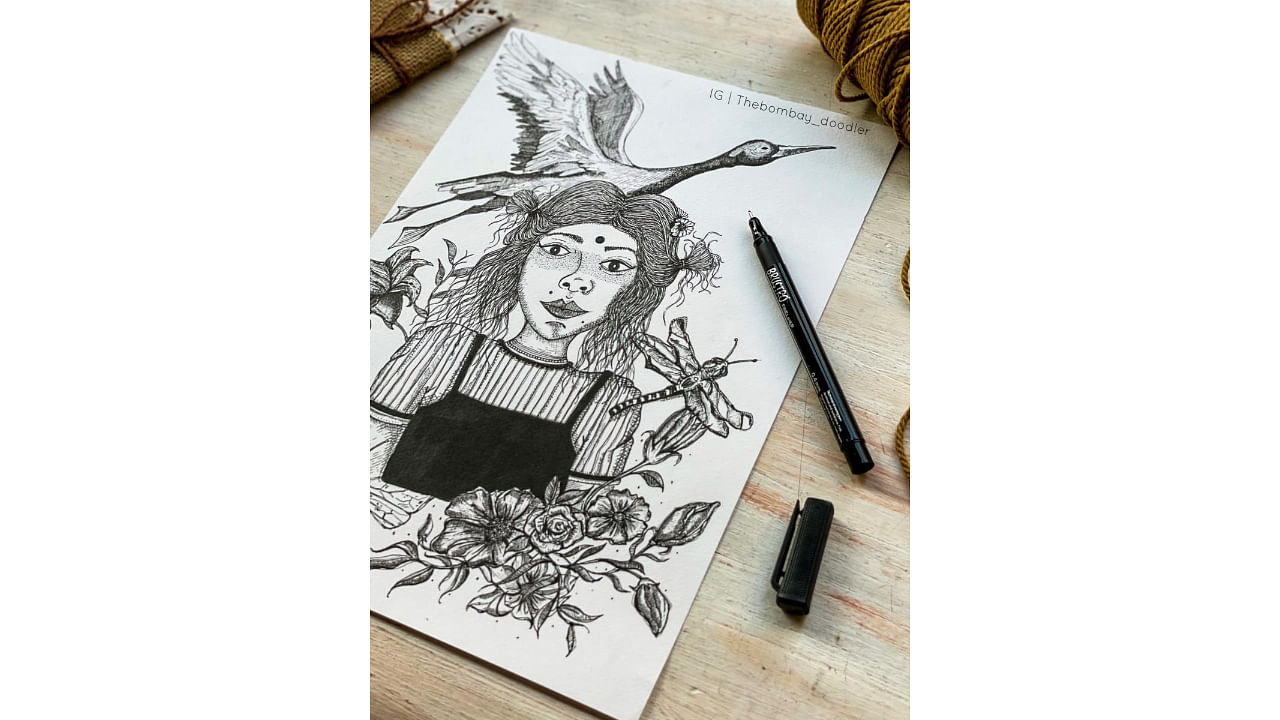

Remember scribbling on the last page of your school notebook, just for the joy of it? Random words, names, crazy characters, and cartoons — the pages weren’t short of variety.
Doodling, as the art form is called, is now being seriously pursued by many. The artistes — known as doodlers — don’t just scribble. They invest time and thought into their works, which are mostly in black and white and some painted in bright colours.
Pradeep Joshna Das, aka thebombay_doodler on Instagram, loves working with black and white. “Not many understood the art, which is not colourful. This is what pushed me to start narrating stories and different topics through my works,” says the artist from Mumbai, who has around 39,000 Instagram followers.
Pradeep started doodling in 2016, a time when there were hardly 4-5 popular artists in the country, he says. Doodle art has drastically changed in India since then, he observes. “Every second person wants to be a doodle artist today,” he says.
Artists online have inspired many, like Vaisakh Anil Kumar, a 12-standard student from Bengaluru, who works on semi-realistic doodles. “I was inspired by Vexx on Instagram and started doodling around five years ago. I used design elements that were seen in his works but later developed my own style. I mostly draw animals and sometimes also touch subjects like mental health,” he says.
Anagha Dandekar, head of content and marketing with a broking company in Mumbai, has more than 16,300 followers on her Instagram page for colourful doodles. “Doodling gives you the freedom to express yourself. Doodles are very engaging and can inspire anyone to pick up the art,” she says.
Design details
Artistes like Pradeep take 90 minutes to two hours to work on a doodle, on an A4 size paper. He makes grids with a ruler and pencil and then works on the characters, their details and other design elements.
Pradeep has always “believed in details”. “I closely work with emotions — love, betrayal and hope, among others. I create different characters and personalities with these,” he says.
For Vaisakh, doodling is just scribbling when in the middle of a class. “But, when I sit down to doodle, I work with a plan in mind, make a rough sketch and plan it,” says Vaisakh, who also learns from social media posts and YouTube tutorials.
Nature is one of Anagha’s favourite themes. “Living amidst concrete jungles, greenery is the best form of relaxation. I also like working with mixed architecture,” she says.
She is also a fan of history. She doodles whenever she visits forts, palaces, and castles. “Whenever I travelled, I would make a few doodles, which would be the stories I wanted to tell at those places. For me, doodling is about storytelling in a short, fun, and easy format,” she says.
“During the pandemic, I wasn’t able to travel. This helped me internalise things and I started reading more about philosophy and economics, which influence my works now,” she says.
Doodling, though an easy art form, requires research and inspiration that needs time on hand, notes Anagha. “I look at images and photographs and write down what I feel. I also look for inspiration across the Internet and things around me,” says Anagha. She discovered her love for calligraphy recently. “The next step is about bringing elements together and adding words to complete the works.”
Equipment
Not much money needs to be spent on this art form, which is also a reason behind the increased interest, feels Pradeep. There are no specific tools needed to create a doodle, say most doodle artists. Pradeep uses a fine liner from Brewster, technical brushes, brush pens, a fountain pen, pencil for a basic stencil, and an eraser. “Nibs and pen points matter as you start discovering your style,” he adds.
Vaisakh uses a simple art book to draw on, regular pens and pencils, and a black Rorito Robomax pen for outlines and pencil colours to fill in.
Anagha started with basic sketch pens, pen nibs, and ink form. “I slowly graduated to watercolours, mixing different watercolours and oil colours. I now work with these and ink, as they are very fluid,” she says. But, a pen on paper with black, white and a little red are her standard choices.
Opportunities
Different opportunities have opened up — many corporate events ask for live doodling sessions now, says Pradeep. “I’ve been invited to events where a speaker talks about his company ethics, values and strategies and I draw these thoughts as doodles on the spot,” he says. Pradeep has also created doodle art for companies like Google, Accenture, among others.
Perfecting skills
Pradeep says practise is the only answer to creating an impressive doodle. “Once you work on doodles for two to three hours daily, you will get better at it,” he says.
Take a pen and paper and “find the space to express and keep going at it”, says Anagha. “Allow your art to grow with you and experiment. Don’t expect too much. You can’t be the next Van Gogh in a minute,” she adds.